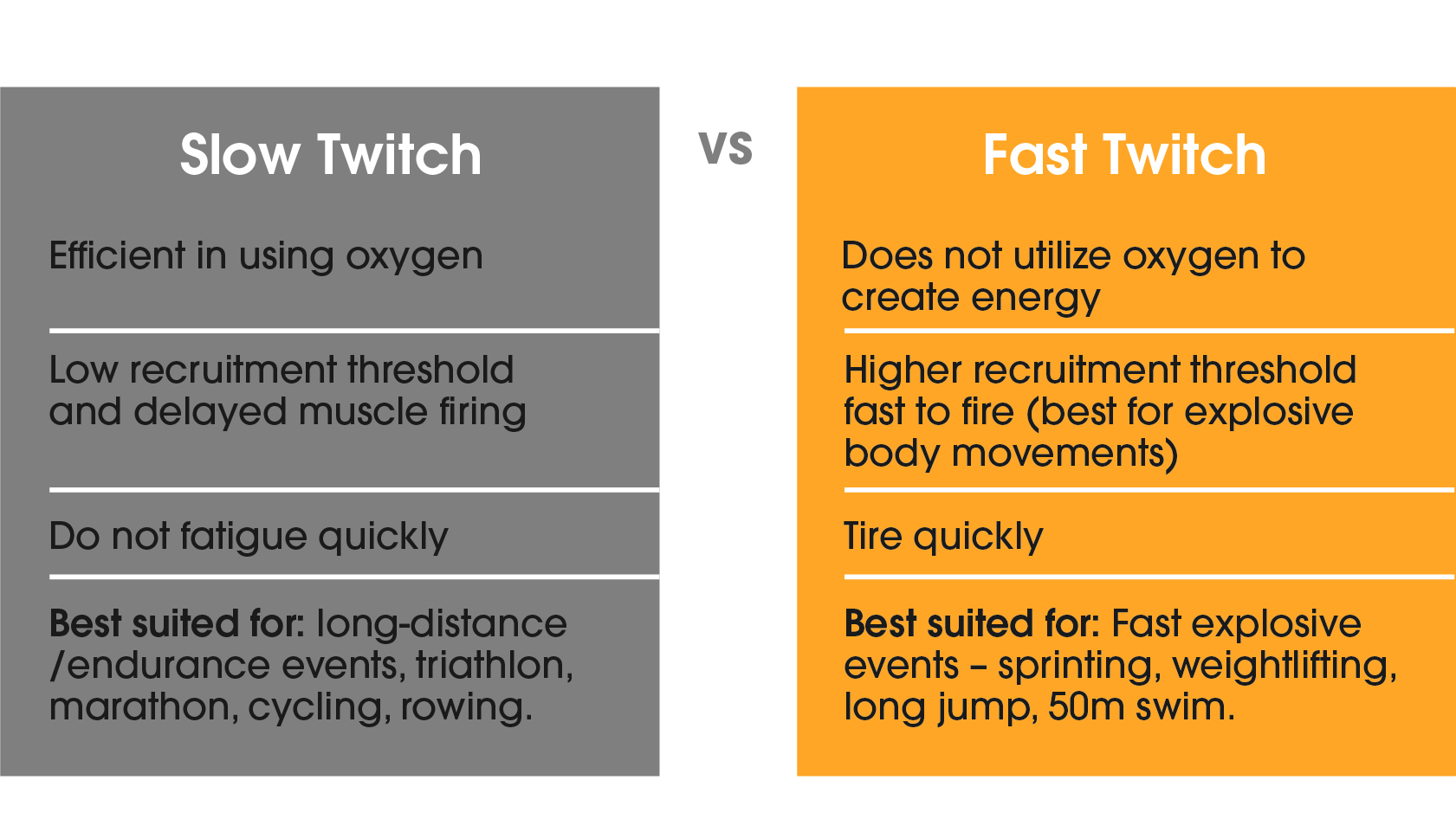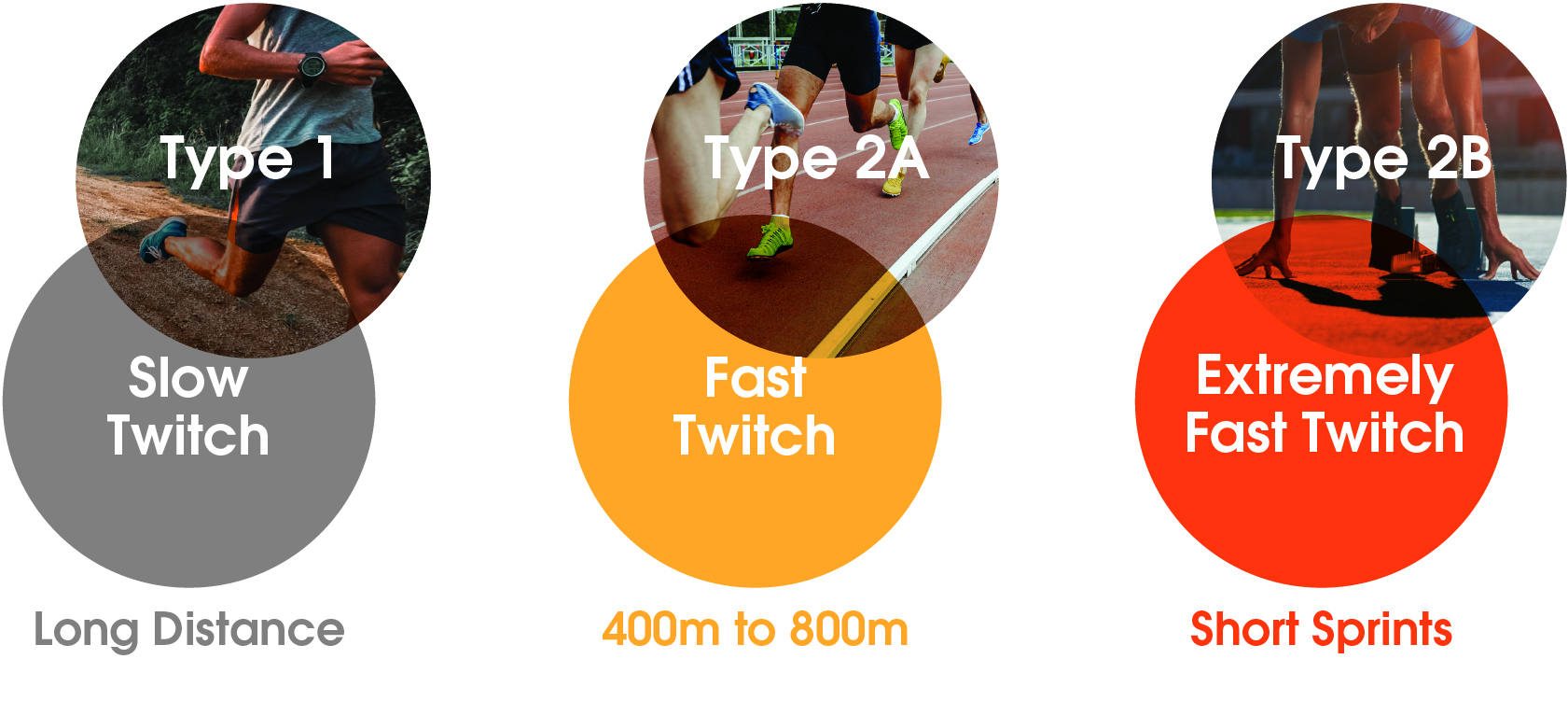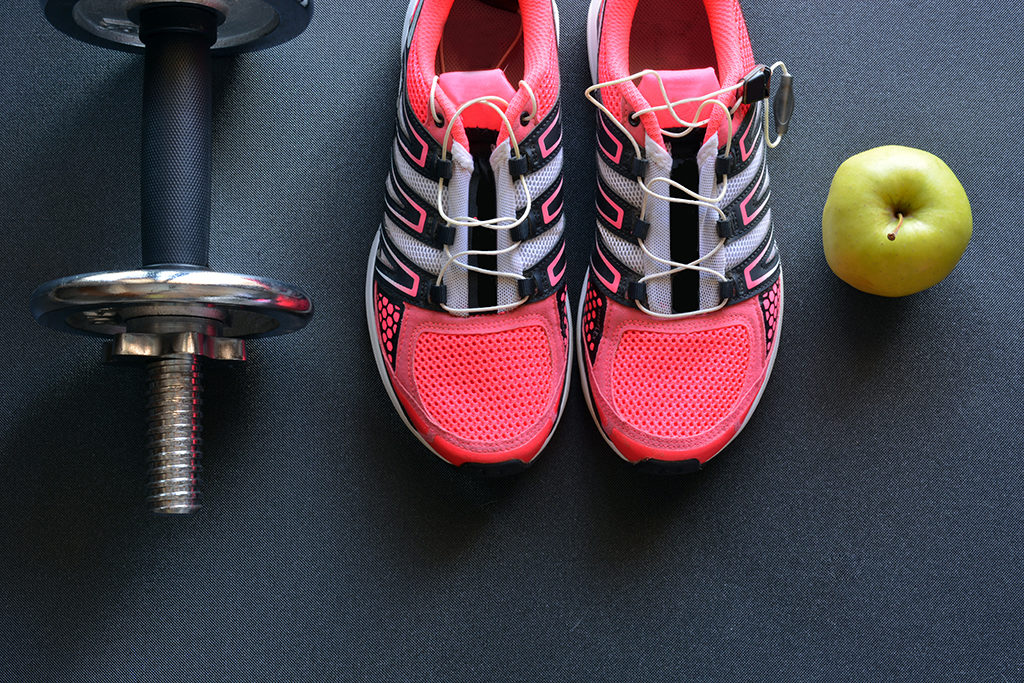You may have heard the terms “slow twitch” and “fast twitch” muscles before. But what are they exactly?
Skeletal muscles are made up of multiple motor units, which contain bundles of nerves and fibres. These muscle fibres can be any combination of two different types: Type 1 “slow twitch” and Type 2A – “fast twitch” (with a subcategory called type 2B – extremely fast contractions).
Each person will have their own unique distribution of muscle fibres within their body. The proportion of each type depends on several factors (genetics primarily) but also the individual muscle itself, a person’s age, level of physical activity, and type of training. The only true way of knowing your muscle fibre distribution is through a muscle biopsy and lab analysis (which does not sound fun!).
There is most certainly a correlation between muscle fibre distribution and athletic ability. The ratio of Type 1 to 2 muscle fibres (slow-twitch vs fast-twitch) determines whether a person would be naturally good at activities requiring powerful/short bursts (sprinting, weightlifting) vs endurance-based activities (marathon running, triathlon).
Muscle Fibre ‘Recruitment’

- To target specific motor units in your exercise endeavours, it is important to understand how the different fibre types are ‘recruited’ or activated during muscle contractions. This is referred to as motor unit recruitment, and each muscle fibre has a different threshold needed before muscle contraction is achieved.
- During any activity, muscle fibres that have a low threshold and slow firing rate will be used first. So that means that slow twitch muscle fibres are used (which is the case for most activities of daily living).
- When you engage your body in an activity that requires greater force production (such as running fast), the slow twitch fibres may not be enough. This is when your body will call upon fast twitch muscle fibres for help.
- Only after slow twitch fibres are recruited, do fast twitch fibres start to fire (first Type 2A and then 2B).
To put it simply, when you engage your body in any physical activity (such as lifting a heavy weight), it will try to achieve this through slow twitch muscle fibres FIRST. If these do not provide enough force to overcome the load requirements, the brain will send signals to your fast twitch muscle fibres to activate and assist. So, if you are training to become stronger, faster, or more powerful – you need to get past the slow twitch muscle recruitment, and exercise the fast twitch muscle fibres i.e., training HEAVY and FAST.
Training to recruit fast twitch muscle fibres
From a sporting and performance perspective – incorporating exercises that target fast twitch muscle fibres can enhance your athletic ability and allow you to get the most out of your training, which may lead to better performances in the sporting arena. Most sports will have activities that require slow AND fast twitch muscle fibre recruitment, so it is important to focus on incorporating both types of training (endurance and strength/power training). Focusing on high-intensity strength training and explosive movements leads to improvements in force and power by recruiting and using fast twitch muscle fibres.
Some examples of activities that will engage a greater amount of fast twitch muscle fibres are:
- High-intensity interval training (cycle 30 seconds easy, 30 seconds hard with increase resistance).
- Swimming short distances (with powerful strokes and kicks).

Heavy weightlifting (clean and jerk, back squats).

Plyometric training (hops, bounds, box jumps, squat jumps).

Speed training (sprinting, agility, ladder drills).
Muscle fibres and the ageing process

Due to the order of recruitment principle which we discussed earlier; slow twitch muscle fibres will remain in regular use as we age. However, as we get older, things tend to slow down. This means that fast twitch muscle fibres are rarely being recruited and are vulnerable to disuse atrophy (muscle wastage). Just like bone mineral density decreases with age, we also lose muscle mass. This decline in muscle mass is a condition known as sarcopenia. During the ageing process there is a gradual decline in muscle mass of roughly 3 – 8% per decade (which accelerates after the sixth decade). This has been attributed to two main causes: a general decline of both slow and fast twitch muscle fibres, but mostly a reduction in fast twitch muscle fibre size. This has a significant impact on force and power production in older adults, leading to reduced muscle mass, reduced strength, lower functional capacity, and increased risk of falls and fractures.
This emphasises how crucial it is to incorporate exercises that target your fast twitch muscle fibres, to combat strength and muscle loss due to the natural ageing process. The old saying “if you don’t use it, you lose it” could not be more accurate in this situation!
You do not need to train like an elite athlete to see benefits!

As I mentioned earlier, performing exercises that are HEAVY and/or FAST are an ideal way to recruit a greater amount of motor units and activate fast twitch muscle fibres, leading to gains in strength, power, and muscle mass. There is no dispute that this method is effective, however, not everyone has the ability or physical capacity to train at such a high intensity (such as the inexperienced or elderly).
Research shows that you do not necessarily need heavy loads to elicit similar results for fast twitch muscle fibre recruitment. In fact, studies have shown that performing resistance exercise to task failure (regardless of load lifted or repetition duration), demands similar activation of your fast twitch muscle fibres and provides an effective training stimulus. In other words, the most important factor is input of effort and feeling like you have worked your muscles (which can be achieved through lighter weights with more repetitions).
Some alternate exercises that can be useful to activate fast twitch muscle fibres include:

- Marching on the spot (as fast as possible)
- Throwing a ball against a wall or floor (be powerful)
- Standing up quickly from a chair (with repetitions)
- Shadow boxing (fast punches; you can even hold little hand weights)
Remember; as long are you are putting in effort and pushing towards muscular fatigue, the full spectrum of muscle fibres (slow and fast twitch) will be working!
For more information on exercise for Type 2 muscle fibre development and retention, our team of Exercise Physiologists and Physiotherapists can assist you. We can provide a tailored exercise program to suit your needs and lifestyle, provide support and guide you on how to safely implement these exercises into your week. Contact Fluid Physio + Gym for more information on 6646 3766.
Or to book online, simply click here. We are confident we can help you.
For more information on Aaron Pateman visit team bio.
References:
Campos, G., Luecke, T., Wendeln, H., Toma, K., Hagerman, F., Murray, T., Ragg, K., Ratamess, N., Kraemer, W. and Staron, R., 2002. Muscular adaptations in response to three different resistance-training regimens: specificity of repetition maximum training zones. European Journal of Applied Physiology, 88(1-2), pp.50-60.
Lexell, J., Taylor, C. and Sjöström, M., 1988. What is the cause of the ageing atrophy?. Journal of the Neurological Sciences, 84(2-3), pp.275-294.
Morton, R., Sonne, M., Farias Zuniga, A., Mohammad, I., Jones, A., McGlory, C., Keir, P., Potvin, J. and Phillips, S., 2019. Muscle fibre activation is unaffected by load and repetition duration when resistance exercise is performed to task failure. The Journal of Physiology, 597(17), pp.4601-4613.
Netreba, A., Popov, D., Bravyi, Y., Misina, S. and Vinogradova, O., 2009. Physiological effects of low-intensity strength training without relaxation. Human Physiology, 35(4), pp.479-483.







About The Author: Aaron Pateman
More posts by Aaron Pateman